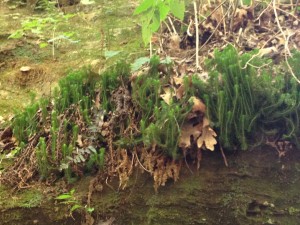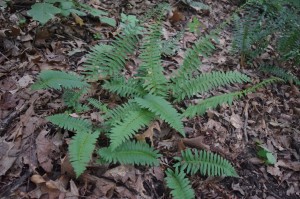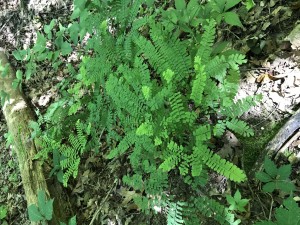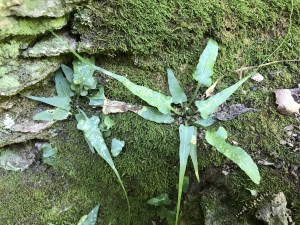Pteridophytes Are Our Friendly Neighborhood Ferns
Are you a lover of Pteridophytes? Do you even notice them when you are out of doors? There are about 11,000 Pteridophytes in the world and about 100 in the North Eastern and Central US. They are the fern and fern allies. Ferns and their allies, the horsetails and clubmosses, occur everywhere except in the arid deserts and high seas. Ferns have been on earth a long time; fossil records date back over 400 million years.
Ferns are vascular plants that have xylem and phloem—xylem to transport water and solutes from the roots to the leaves and phloem to transport food from the leaves to the rest of the plant—and that reproduce by spores. This feature makes them different than most of the plants you encounter every day that are vascular but reproduce via seeds. In other words they have roots, stems and leaves but lack flowers and seed.
Ferns can be differentiated by various means. Their size can vary from tiny to over 19 feet and is often affected by the environment. The shape of the leaf, commonly called a frond, can be very simple or highly complex. The leaflet can be singular, divided once or even thrice-cut, giving them a lacy appearance. Sporangia, or the spore case, also vary in shape, size and location on the frond. The arrangement of veins in the leaflets can also vary from a very simple single vein to a complex netted form. Coloration, absence or presence of hairs, etc. can also vary. All ferns however are perennials.
Ferns have alternate generations but both generations are independent and free living. Life cycles of the fern consist of the plant form we are all familiar with that produces spores (asexual reproduction) that when mature and dry, disperse. Under favorable conditions (moist) they develop into gametophytes in about 2 weeks. Male and female organs develop on the gametophyte, fertilization occurs and new plants develop in about 3 ½ months. The new leaves appear tightly wound and resemble the head of a violin and are thus known as fiddleheads. As they grow they unwind and form the fronds we see.
Many true ferns are common in Southern Illinois and can be seen in our area in moist, wooded locations. The fern ally, horsetails (Equisetum) are commonly seen in the bottoms along ditch banks and field edges. Clubmoss, often referred to as Ground Pines since they resemble pines and cedars, can be found in the woodlands and forests. Several of the fern species that you may encounter are described below.
Christmas fern (Polystichum acrostichoides) is still green at Christmas. Its common name refers to the practice of gathering the evergreen leaves during Christmas time as a holiday decoration. The tapering fronds, which are up to 3 feet in length and 4 inches wide, grow in clusters from a central rootstock. It commonly grows in colonies and occurs on rocky shaded slopes, along wooded stream banks and in ravines. The leaflets are lance-shaped, eared, short stemmed and appear almost opposite on the stem. There may be 20-40 pairs of leaflets. The sporangia or fruit dots occur in two or more rows at the tip of the frond. The leaflets with the sporangia are smaller than the leaflets below.
Common Polypody (Polypodium vulgare), a smaller (12 inch) fern, which is common where rocks and cliffs with rich soil are in shade or semi-shade. The leaves are oblong, lance shaped and deep green on both sides. Leaflets are alternate, winged at the axis and decrease rapidly in size to a prominent tip. The fruit dots are large and round, red-brown in color and are more numerous on upper leaflets.
Maidenhair ferns (Adiantum pedatum) are more unique in form, appearing like a horseshoe-like flat frond borne on erect stalks. Each stalk divides in two parts that bear leaflets on the outer rim. Maidenhair ferns favor rich soils often in ravines and are most abundant in limestone areas. They typically are 16 inches high by 10 inches across. The stems are shiny black to dark brown and are mostly smooth. They usually have 1-5 fruit dots on the upper margin of the leaflets.
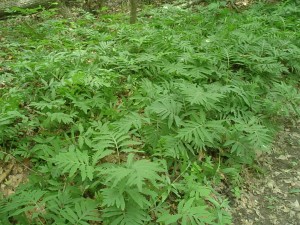
Sensitive fern as seen along Ridgetop Trail, South at White Rock Nature Preserve. Photo courtesy Joann Fricke.
Sensitive fern (Onoclea sensibilis) is often described as unfernlike. It is a sturdy, coarse plant with almost triangular leaves which tilt upward and backward. Sensitive fern dies quickly with the first frost leaving erect, beadlike fertile spikes. They occur in full sun or shade along banks or wood edges. The sterile leaves are about 2 feet tall cut into about 12 pairs of wavy edged leaflets. The fertile leaves are about a foot tall, upright with small branches. The spore cases are contained in small hard beadlike leaflets that turn dark brown when mature.
A unique and smaller fern is the Walking fern (Camptosorus rhizophyllus). The Walking fern has narrow, fine pointed simple leaves that often sprout a new plant at the tip when touching the ground. Old plants can be surrounded by new attached plants so it walks or spreads. It occurs on shaded, moss-grown faces of limestone cliffs or boulders or cracks on moist limestone outcroppings. The leaves are about 6 inches long, evergreen and slightly leathery. The fruit dots are scattered over the undersurface from base to the tip and are brown in color.
The next time you are out in the woods, summer or winter, look around and see how many of the fern or fern allies you can spot. Take a closer look and observe their varying shapes, look for the fiddleheads, examine the location and shape of the sporangia. There are several species in our local woods at White Rock Nature Preserve, as well as Salt Lick Point Land and Water Reserve and Fults Hill Prairie Nature Preserve. Watch out, you might become a pteridologist!
CLIFFTOP, a local nonprofit organization, is focused on preserving and protecting area blufflands.
A version of this article appeared in the July 6, 2018 edition of the Monroe County Independent.
© 2018 all content rights reserved Clifftop NFP.
Comments are currently closed.

